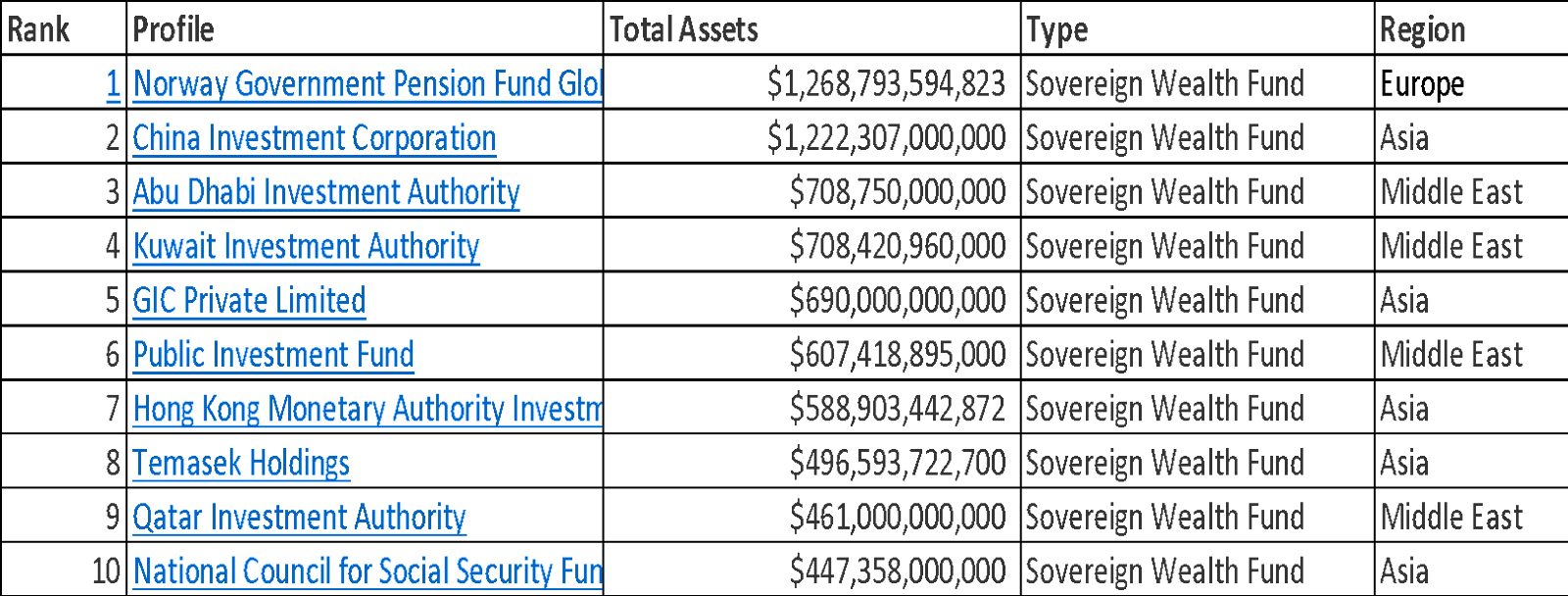Sovereign Wealth Funds (SWF) have become diversified investment vehicles that invest across equity and fixed income products, but also are active players in private equity and in early-stage tech companies. As we look at the global landscape for SWFs, it is not surprising that of the largest 10 SWF, with a combined $7.6 trillion in assets, 70 percent of these are from oil and gas producers.

What are sovereign wealth funds?
A sovereign wealth fund is a state-owned investment fund investing money generated by the government, often derived from a country’s surplus reserves and natural resource industries. SWFs aim to build wealth for a country’s economy and its citizens.
Popular sources of SWF are surplus from state-owned oil and gas, and trade surpluses. SWF are used to preserve capital and generate financial returns that can be used to increase prosperity of a country and its citizens. Oil and gas producers are known for using their SWF to diversify their investments away from energy and to boost the country’s competitiveness. This is a well-known strategy in the Gulf Cooperation Council (GCC). Wealthy nations traditionally use sovereign wealth funds to invest surplus billions overseas to prevent inflation at home, diversify income streams and accumulate savings. Norway and Chile are two good examples using their SWFs to save oil and copper revenues respectively in the form of sovereign wealth funds. These actions have prevented these two resource rich countries from experiencing Dutch Disease, also known as the ‘resource curse’ which could have led to high inflation at home and affected competitiveness across other less strategic sectors.
The Gulf Cooperation Council SWF are different
While Kuwait’s sovereign wealth fund was the first global SWF to be established in 1953, most GCC SWF were created following the oil and gas booms of the 70s, and they very much followed the Norway traditional model of structure and investment strategy. They are all controlled by the ruling families, such as with Saudi Crown Prince Mohammed bin Salman (MBS) as Chairman of the Public Investment Fund (PIF) and Emirati President Sheikh Khalifa bin Zayed Al Nahyan as Chairman of the Abu Dhabi Investment Authority (ADIA). In so doing, these monarchies can maintain close control over how the countries’ resource wealth is spent and align that spending with their political, public, and personal objectives.
Most SWFs in the GCC are commodity-based funds, though a small proportion represent non-commodity funds equivalent to 7% of total fund assets. Overall, the Gulf “Magnificent Seven” SWF have combined assets of $3,2 trillion amounting to approximately 40% of SWFs global assets. These seven SWF are the Abu Dhabi Investment Authority ($829 billion), the Kuwait Investment Authority ($769 billion), the Saudi Public Investment Fund ($620 billion), the Qatar Investment Authority ($445 billion), the Investment Corporation of Dubai ($300 billion), Abu Dhabi’s Mubadala ($284 billion) and Abu Dhabi ADQ ($108 billion). The state-owned investment funds invest in equity, bonds, realestate, startup, and any other asset class that can lead to frothy returns.
The GCC particularly, Qatar, Saudi and Abu-Dhabi, have used sovereign vehicles to promote their political agenda, and have become prominent investors in tourism, arts, cities development (at home), football, golf, and formula one. Saudi Arabia, Qatar and UAE have been promoting local real estate and property investment funding the infrastructure needed for new cities, as well as housing complexes, and ports, hoping to attract cosmopolitan foreign residents and businesses. Generally speaking, GCC SWF invests in iconic projects such as in the 500-billion-dollar NEOM city (in Saudi Arabia), which require massive financing resources, and which aims to promote the national brand projecting international prestige.
Other caliber of sovereign wealth fund
Smaller and less financially endowed countries, ranging from Morocco, Mauritius, and Panama, have also developed their own strategic investment fund. While these are smaller in size, ranging from $500 million to $1,5 billion, they all aim to get on the global map, and become more trustworthy as they seek to invest their revenue streams more responsibly. These types of funds tend to be common in countries which are over-dependent on one type of revenue source, Mauritius relying on tourism, and Panama, relying on its canal operations and refueling capabilities.
What to expect going forward?
As climate regulation, sustainability investment and ESG pressure accelerates, oil gas and minerals dependent countries will take more risk and diversify aggressively their investments and shift away from oil and gas. This is why Saudi Arabia and Abu Dhabi are becoming the biggest supporters of Blue Hydrogen (derived from fossil fuels) which creates the infrastructure to make Green Hydrogen cost competitive. GCC countries through their SWFs are becoming the biggest investors and promoters at home of sustainable futuristic cities. In other words, by 2050, GCC countries could be the leading renewable energy producing countries in the world, owners of “zero emission cities” of the world, and pioneers of clean tech and sustainable farming. Time to buckle up!
 Share on bsky
Share on bsky





Read 1 comment and reply